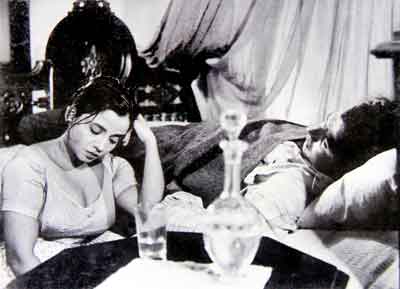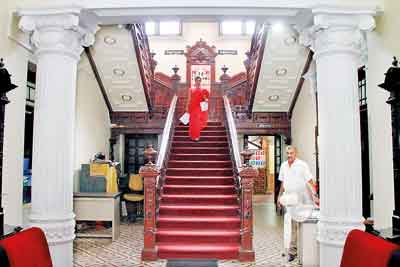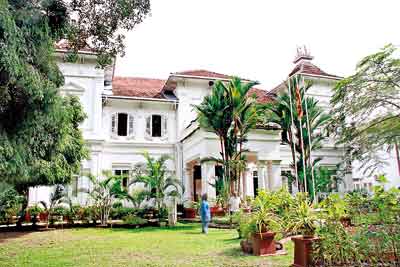The blossoming of ‘Parasathu mal’

Chithra Balasuriya: Getting into films was by accident. Pix by Indika Handuwala
When Chithra Balasuriya set out to produce a film about an aristocratic landowner given to wine, women and song titled ‘ Parasathu mal’ , little did he realize that five decades later, the film would continue to generate the same kind of interest it did when it was first released in 1966.
The success of his debut film production took Balasuriya by surprise and today at the age of 85, he still wonders how luck played a role in putting him at the right place at the right time amidst a group of immensely talented people who contributed to making “Parasathu mal” the masterpiece it blossomed into.
Balasuriya’s advent into film production was accidental. ”I had no idea of ever producing a film. My mother had enough money so I was not keen to get a nine-to- five job and having finished my schooling I decided to help out at a photo studio in Gampaha. “I was keen to see the inside of a studio. As its owner was known to my parents he allowed me to come there. And even though I was reluctant, he taught me how to take photographs,” he recalled.
A few years after working at the studio, its proprietor encouraged Balasuriya to open a studio of his own in the Gampaha town. So in 1964 Chithra Photo opened its doors and it was here that Balasuriya came into contact with some of the men in whose company he developed a love for cinema.
“Lionel Algama was a schoolmate of mine and he would visit me often in the studio. He was also a friend of Amaradeva’s, who, though hailing from Moratuwa, made frequent visits to Gampaha to have his clothes tailored,” he said. Dayananda Gunawardena and Mahagama Sekera were also among others who joined them regularly where the conversations would centre on movies and music and it was on one of those evenings a suggestion was made that Balasuriya produce a film.
“I had no idea how to go about it but agreed to fund a film production,” he said.

Gamini Fonseka and Punya Heendeniya played lead roles in the film
The first step was to get a good script and in this quest he was helped by Dharmadasa Kuruppu, who later went onto act in many Sinhala films as well as in the Hollywood blockbuster Indiana Jones and the Temple of Doom. Kuruppu suggested they meet P.K.D. Seneviratne who was an up and coming script writer with two films namely Kurulu bedda and Sikuru tharuwa under his belt.
“It was my first meeting with P.K.D. and I was immediately struck by his humility. When I requested him to write a script he told me he was working on a script and asked me to return in two weeks,” Balasuriya said.
When he returned, with no preconditions whatsoever, P.K.D. handed him the script – the story of a wealthy landowner whose over-indulgent lifestyle leads to a tragic end.
Balasuriya’s next move was to approach Lester James Peries to direct the film but due to commitments to another producer, he was unable to take it on but suggested that he consider up and coming actor Gamini Fonseka to direct it.
“Lester promised all the assistance towards my production and introduced me to Gamini Fonseka. I had never met him before but had heard he was an adambarakaraya (a proud person) .That did not deter me as I was a bigger adambarakaraya,” Balasuriya said.
The meeting between the Balasuriya and Fonseka set in motion the mammoth film production into which were roped in popular film actors of the day including Punya Heendeniya, Tony Ranasinghe , D.R.Nanayakkara as well as newcomer Anula Karunatillake who went onto make her mark as a popular actor in Sinhala cinema in later years.
“I found no arrogance in Gamini at all when I got to know him. I chose all the actors for the main roles in the film and he did not disagree with any of my choices,” he said.
The next step was finding a location and having grown up in Gampaha, his sights fell on a legendary walauwa in the area, “Agra”, the palatial house built by one of the richest men in the area D.D. Karunaratne.
“I had visited the house when I was a child and was impressed by its beautiful and imposing interior. By the time I decided to produce the film, the ownership of the house had passed onto the eldest daughter of D.D.Karunaratne. I visited her and requested her permission to use it as the location for the film but she refused,” he said.
Not one to easily give up, Balasuriya found another way to have the movie shot at “Agra”. “The lady was married to a gentleman who was then the Director General of the Irrigation Department. As luck would have it, P.K.D. who was a close acquaintance of the then Prime Minister Dudley Senanayake was working as his public relations officer. I used a bit of coercion through the contact with the PM’s Office to get the house owners to agree to allow us to shoot the film at “Agra.” We were allowed the use of the house but with strict conditions. No one was allowed to enter without first washing their feet,” he recalled.
The film shooting lasted more than a year and it took the skills of one man to turn a black and white film into one of the most excellent pieces of cinematic work ever done in the country.
“The most important factor that contributed to making “Parasathu mal” into what it became was the cinematographer Sumitta Amarasinghe. If not for him the film would never have been completed the way it was.”
While Gamini Fonseka who directed the film also played the lead role of Bonnie Mahattaya it was Amarasinghe, who from behind the camera directed Fonseka using his camera handiwork to convey different emotions that even today leave audiences awe struck.
“It was my good fortune that all these people came together, “ said Balasuriya whose only other film production was “Thunman handiya’ written and directed by Mahagama Sekera in 1970.
“Making a film is like making a good curry, you can add coconut milk and all the spices but without the proper athgune, it won’t taste good,” he said.
‘Agra’ the setting for a legendary film  Agra’s imposing interior: From family home to government office The story of “Agra”, the house located at Bendiyamulla in Gampaha in which much of “Parasathu mal” was filmed is almost as fascinating as the story of Bonnie Mahattaya on whose life the film is centred. The house was built by D.D.Karunaratne on 72 acres of land and he came to occupy it in 1935 along with his wife and two daughters. It was named “Agra” as artisans from India had been brought down to complete the work on the house. Karunaratne was not only one of the wealthiest men in Gampaha but also served as a Senator having been elected to the Senate from the Gampaha District in the country’s first parliamentary election in 1947. His elder daughter had inherited the house in later years but by the mid-1970s, there were no direct descendants to claim the property and it ended up in the government’s hands. The palatial house today is the office of the District Secretariat of Gampaha, a busy government office housing over 400 employees. It was acquired by the Government in 1978 along with 12 acres of land at a cost of around Rs15 million paid as compensation to next of kin. It’s been the office of the Gampaha Government Agent (now District Secretariat) since Gampaha became a separate administrative district. District Secretary Sunil Jayalath says the structure of the house has been retained in the best possible manner but some changes have been made to turn it into an office space. “We have an inventory on all the furniture that was acquired with the house. Most of them are well preserved and are kept here,” he said. The entire list of the raw material purchased to build the house is in the DS’s possession and contains details of costs incurred for the building materials including floor tiles, wood for the floor and stairs, mirrors, bathroom fittings etc.  One of Gampaha’s stately homes: Agra, much in use today ‘We do not know who designed the house but even by today’s standards it is a fascinating piece of architecture,” Mr. Jayalath said. While its imposing stairway immediately draws the eye, the eight bedroom house with servants quarters and French windows to ensure proper ventilation and intricately designed ceilings leaves one wondering how the house would have looked in its heyday. The furniture, all made of nedun wood, contains carvings, some including folk tales such as the story of the fox and the grape, the fox and the crow etc. A fascinating aspect is the manner in which mirrors have been installed at the top of the stairway so that they serve in the manner in which CCTV does in the present day by giving a person standing on the top floor landing of the house a view of the front door and those who enter and exit through the house. Not many who visit the DS office know about the history of the house or the people who once occupied it. Nor are they aware that it was the setting for a legendary Sinhala film which in 1997 was picked by a government appointed committee as one of the ten best films made in the first 50 years of Sri Lankan cinema. | |


